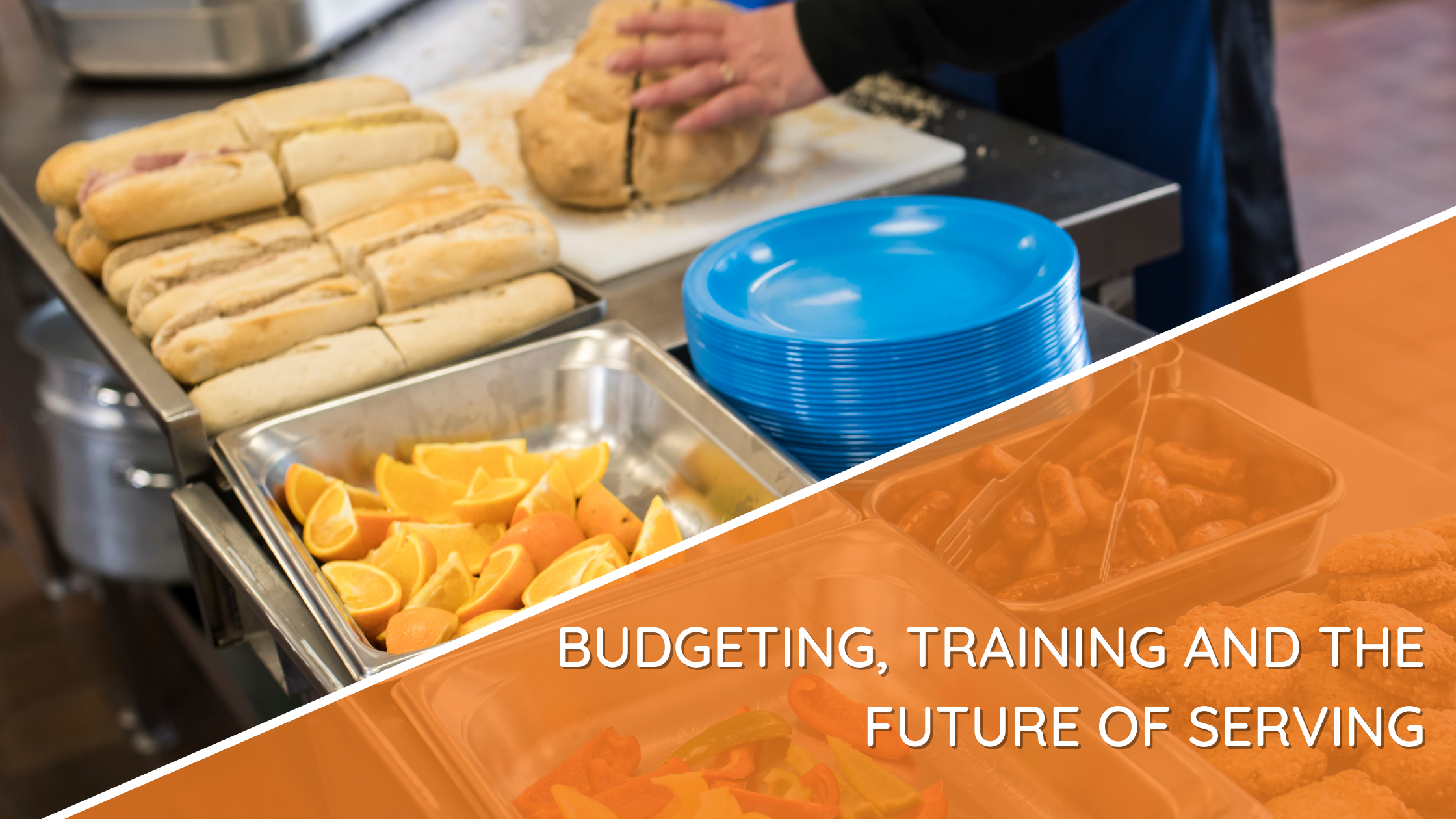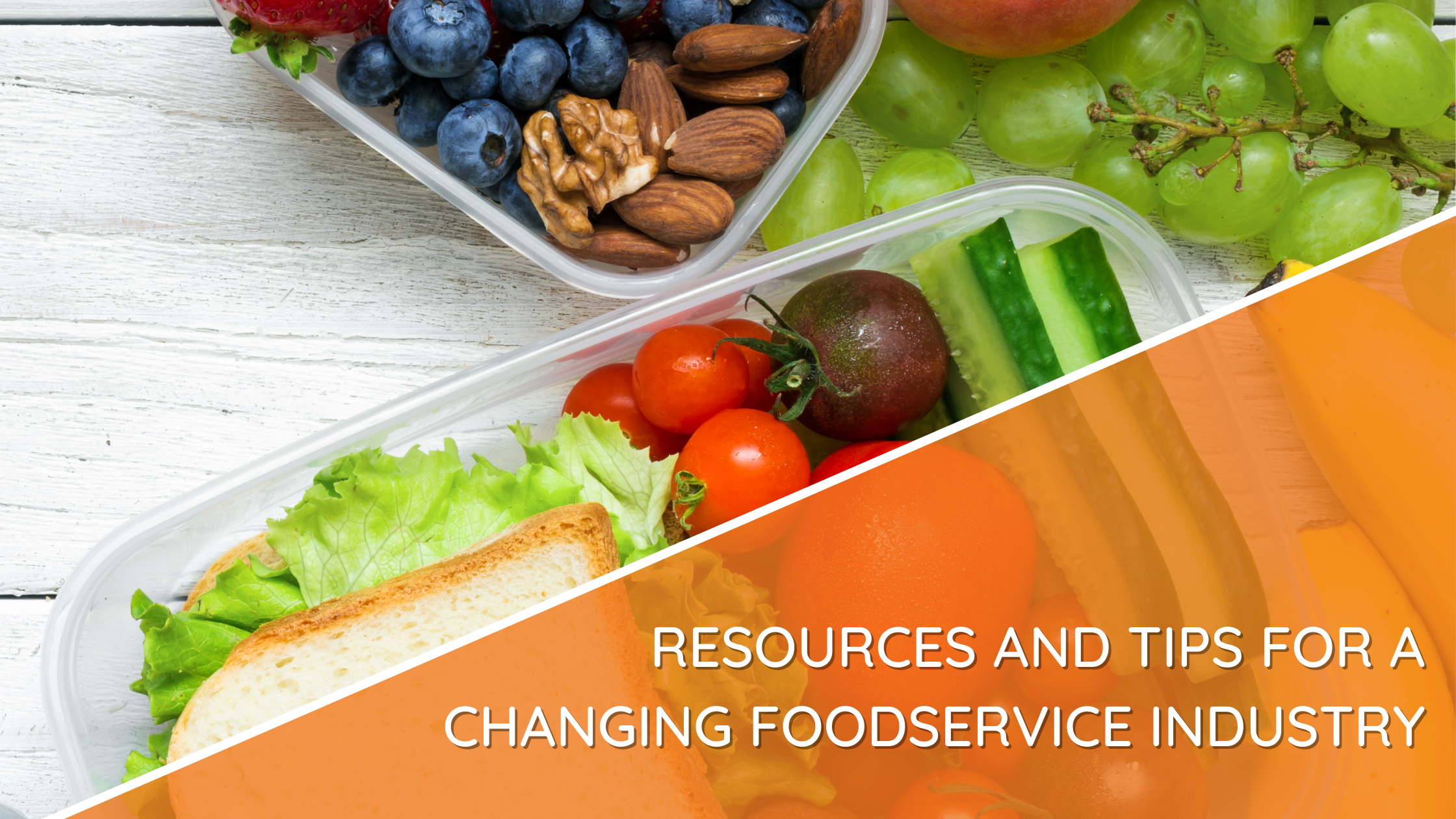Budgeting, Training and the Future of Serving
With Bart Christian, who is a nationally recognized speaker and the school nutrition industry, and Lindsay Aguilar, (Registered Dietitian and certified School Nutrition Specialist), the Administrative Dietitian for the Tucson Unified School District Food Services Department.
School Nutrition Education Program
Budgeting, Training and the Future of Serving
USDA Professional Standards Code 3330/4120/4130/4150/4160
Guest
Bart Christian, who is a nationally recognized speaker and the school nutrition industry.
Lindsay Aguilar, (Registered Dietitian and certified School Nutrition Specialist) is the Administrative
Dietitian for the Tucson Unified School District Food Services Department. Lindsay has worked at TUSD
for 15 years where she coordinates the operations of the various federal meal programs throughout the
district and nutrition support services. Lindsay has a passion for child nutrition and the importance of
the role of nutrition in education. Lindsay is an active member of the School Nutrition Association and is
on the executive board for the state association.
How are meals delivered during this time of the pandemic at Tucson Unified?
On March 25th, we started a grab and go meals with 12 bus routes. We had 114 bus stops across our
district. Our district is 225 square miles so we covered pretty much the majority of the Tucson area.
We did breakfast and lunch at one time. Our buses were out between 10 and about one 30 every day.
Actually, today is our last day of those bus routes for the school closure. We served just over 330,000
meals over the last two months to our community and then we’re starting back up on Tuesday with a
revised summer bus route.
What types of variety of meals and items are you serving in those grabs and go lunches?
We have been utilizing all pre-packaged items. Fortunately for us at TUSD, we had incorporated a 50- 50
model over the past two years so we’re doing half of our entree house-made assembled items that
we’re making in our kitchens and then we have incorporated pre-packaged items.
We were fortunate that we had quite an inventory. We have a centralized warehouse, so we have been
able to run our program off of the five-week inventory that we had coming into the school closure. We
weren’t in the situation that I know a lot of districts across the country really had challenges getting prepackaged items.
Some of the meal items that we served were:
– bean and cheese burritos
– corn dogs
– cheeseburger
– sliders
– grilled cheese
For breakfast items we’ve had:
– cereal and bagels
– pancakes
– French toast
– fruit cups
– fruit and vegetable juice
What are the issues that you faced while delivering the lunches and what was your alternative plan to get around with it?
We’ve had issues with shelf stable milk. We had a large inventory of that but it ran out on the first
month so we had to transition to regular fluid milk. Hand sanitizers for buses has been a challenge too
so we had to get creative with that and kind of figure out an alternative plan for that.
What is the response of the parents to the fact that you’re bringing food to kids and the type of food
they are receiving?
It actually has been overwhelmingly positive. The kids are making cards and pictures. They draw chalk
on the bus stops and sidewalks to thank us and hanging signs. We even had one family that made Tshirts for the staff on the bus that said “TUSD United”
I think the other factor is just the people are coming together and collaborating with our transportation
department and our school safety. We have school safety officers and crossing guards that have been
out at our bus stops. So just working together with those departments in such a positive way and
impacting our students and community has been my favorite part. It has been really nice for our staff as
well to get the positive recognition that they often, unfortunately don’t receive.
We are going to be elevated as an industry to such a high level in the district, because we’ve really
demonstrated that the food service workers are essential because they’re the ones who have had to go
to work.
That school lunch often has those misconceptions parents being exposed to the food has also been a
really positive kind of unintended consequence from this whole thing. Every day they take their kids to
the meal stops and they’ve been actually able to see the food they are getting. The food quality and just
being able to see the types of items that we offer to their kids has been a really nice impact for
everybody to experience.
What exactly are you doing with your staff to keep them engaged and keep them motivated on a on a
daily basis?
We have just over 200 site employees in our school kitchen. We obviously didn’t need all 200 on the bus
routes and in our central kitchen facility so we did a weekly rotation. We had groups of people assigned
to our kitchen to do our meal bag assembly. Then we had the groups of staff assigned to the buses for
the meal distribution. Then we had group of staff rotating to work from home.
We utilize this time to really educate and train our employees. The School Food Handler program has
been amazing to our staff to utilize during this time and keep them working and having meaningful work
and they did a lot of professional development training.
We also utilize some other areas too. The Institute of child nutrition was something I assigned staff from
home just which they actually got a lot of feedback that they really enjoyed. Learning about the history
of the National School Lunch Program and then our district actually has a historical section on their
website.
I had them review all the history of TUSD and I was surprised that a lot of our staff reached out to me
just saying that they really enjoy learning about the history of the district and they do a really good job
with some stories and archives and stuff like that.
It’s been a combination of food safety training, nutrition education, and utilizing our state department
website as well for some of their trainings on the meal pattern. So, I think, a lot of people have provided
some feedback to me that they actually enjoy being able to have time to expand their knowledge in all
of these areas and take time to do the trainings and do all the trainings on school food handler where
we had them complete every single training that was on the website.
Thank you all for having those great resources available for us to use.
Advantages training your employees during the pandemic:
– Your staff is going to come back more knowledgeable and educated.
– They are going to feel better about themselves and the job they do.
– They are getting more exposed to areas they normally wouldn’t have the opportunity to learn
about.
– It has given the staff a lot more confidence in technology.
What type of other technology related tools have you been implementing over the past couple of
months?
– Powerpoint Presentations
– Zoom
– Office 365
In the past years, pre COVID and everything, did you all do any type of professional development day to start the year off for new hires and what do you anticipate for the future for getting those new
hires up to speed on where they need to be to start the year off?
Normally in the past, they would go through the district onboarding process. So that will stay the same,
but there is some training that they receive at the district level. Once they start with us, the new hire
training was just all in the kitchens.
We had a training guide that was completed for staff to go over certain areas and sign-off. So, I think
from this and the feedback that we’re getting from our staff, looking at the training guides, we’ll
definitely look to incorporate some more interactive and some technology pieces.
I think that videos are something that I’m definitely interested in. Either putting together some trainings
that include more realistic videos of our kitchen set up is and those areas to make it a more effective
piece for our new hires because we don’t have the capacity to bring them all in at one time. We were
hiring so many people throughout the year and they all started at different times. So we rely on our sites
to complete that training an utilizing some of the technology for that is definitely something that we’re 6
planning to incorporate.
What do you see happening for those large beginning of the year meeting for either managers or
segments of the team, or maybe the whole team?
I do definitely think there’s going to be some changes to our typical bringing everybody in and large
groups, especially for the start the school. We need to keep groups to 10 and under, and those things at
this moment in time, but even moving beyond that, I do think that from this whole experience, we’ve
definitely captured that you can still have effective meetings and interactions.
I do think it is important and our staff really loves to be around each other. So, I think that human
contact is definitely needed. But I do think that we can do some hybrids and smaller groups and utilize
the technology to have more consistent interaction with our employees instead of waiting to do it once
every quarter, we could set up things more consistently.
I definitely think this is going to change our staff meetings and trainings and in-services moving forward
for sure and across our district as well. I think it’s something that it’s going to be forever changed from
this entire experience. I also think that it’s going to be okay and positive things are going to come out of
this. I think we’ll all be stronger and have even better and more efficient programs because of things
that we’re going to have to do.
This is also going to allow us to be more connected with our staff much more consistently because now
we’ve got ways that we can utilize that can keep them feeling more supported and connected with our
central office.
What types of things are you considering this year when you’re looking at budgeting for this upcoming year?
I think at this point, the priority for us right now is just devising our reopening plans.
I’m working on kind of the four phases, we’re working on traditional students coming back a hybrid
model of some in their schools, some online. Preparing if, hope to God, we don’t have to go back to
schools being closed in online only. Then also the fourth option, because of some of the protocols and
changes that our district is going to have to make potentially that some kids would be scheduled in the
school building on certain days and at home others.
So, we have these kind of four phases that we’re working on reopening plans for. I think that the
challenging part and my concern of course is, what is this going to do to our participation levels? And if
we do have a percentage or population of our students that are going to be, online from home, how can
we still encapsulate providing meals to those students?
Of course, there would have to be regulation changes at the USDA level and our state level and I think
not just for food service but for education in general. I think participation levels are certainly definitely a
priority concern and then of course our budget, as far as our revenue loss, that we’ve experienced
tremendous losses as we conclude this physical year and how can we recover from that going into next
year. What are our school enrollment numbers going to look like? We’re in the process of doing a big
district survey as far as our family is going to be ready to come back in the fall and check if they feel
safe?
We’re working on building our real pain plants to ensure the safety of all students and staff as a priority.
With how these last few months has been running, decisions are going to have to be made quickly. You
can plan for all of this and then it’s going to be the constant change and adjustments that we’re going to
have to make.
At this point I think that’s the hardest budgeting piece is because there are just so many unknowns in
meal service models. What kind of service are we going to have? Is it going to be in the classroom?
Fortunately for us, we’ve been running a kind of a self-serve model at our elementary is where we
package all of the food.
So that is to our advantage. I think coming into this with the kind of grab and go concept is probably
going to be most likely what we’re going to have to do because of the physical distancing and those
protocols that we’re going to have to have in place, but is that going to be in the cafeteria or in the
classroom?
With a lot of the procedures that you’ve obviously been forced to implement over the past couple of
months, do you see any of those procedures carrying into this upcoming school year?
At this point, our district does have a face covering protocol in place for employees that are going to be
serving the public or working around others. So, I think, first the start of school, that’s something that
I’m preparing for . Ourstaff is most likely going to need to wear masks when they’re interacting with
students and other staff. I certainly think some additional cleaning protocols, disinfecting and taking
those extra precautionary steps that we’ve been doing is something that we’re going to continue to
carry forward. I think also just kind of looking at how some of our kitchens are set up and spacing and
some of our flow is something that you needs to be reviewed because if we are going to have to be
mindful of still trying to distance ourselves when we can, even if it’s not always possible, but that’s
something that we did during this time for our centralized kitchen facility.
We actually had place markers set with tape on the ground at our assembly lines to keep everybody six
feet apart and really trying to be mindful of that in our operations. So, I think, looking at our footprints
in our kitchens and what adjustments might we be able to make is something that we’re going to be
working on.
Any last pieces of advice that you have for foodservice workers and nutrition professionals across the country that you’d like to share as they’re planning and heading into this upcoming school year?
Make sure that you’re connecting with your district. I know oftentimes food service departments can
sometimes struggle to be connected and involved with the entire district, but certainly that’s something
that’s essential right now.
We need to connect with operations and all the different protocols and procedures that are going to be
implemented. If that’s not something that normally happens in your district, I think just making sure that
you’re inserting yourself in those conversations and not just hanging back because you can’t do it alone.
You need the support of your district and working with other departments and making sure everybody’s
on the same page. I think that’s something very important and some of those partnerships, connections,
I think is essential as we move forward into these challenging and unknown times.
Use the word, insert yourself into the conversation. I think there’s some districts where you’re going to
have to force yourself into the conversation. I think sometimes child nutrition feels like we’re on the
outside looking in. Not only can we not do it alone, they can’t do it without us. And that’s just the truth.
Whatever your level is, make that clear to your district, because you’ve been blessed to have a very
steady hand in what’s going on in your district in Tucson.
I just hope that the supervisor, the superintendents, the principals, these board members that have not
always given voice to child nutrition will realize exactly how vital and important these true superheroes
are on the job they do every single day.
I think this whole experience has helped most districts to get that well overdue acknowledgment. We
need to just ride that way for sure. Make sure you don’t pull back. Just keep the momentum going for
sure.



